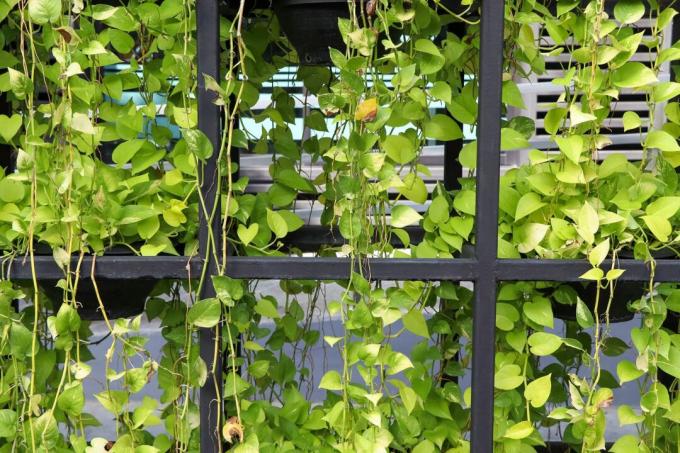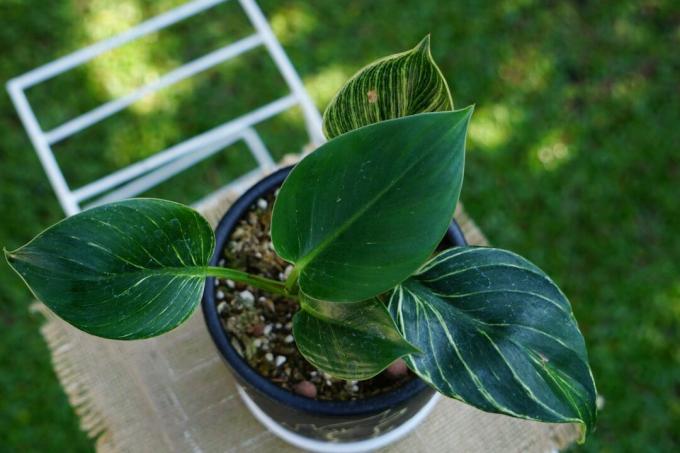The efeutute is a tropical plant and can therefore only be kept in our rooms. You can find out what the ideal location looks like here.

Versatile, decorative and easy to care for: That describes the Efeutute (Epipremnum) in a nutshell. Whether as a traffic light plant, for planting in pots, as a climbing plant or as a wall and window greening - it looks great everywhere. Due to its filter properties, it is popular in the aquarium as well as in offices and apartments. The efeutute can absorb toxins such as formaldehyde from the ambient air and store them in their plant parts. The poisonous substances are then processed in the plant parts and rendered harmless.
contents
- Efeutute: origin and characteristics
-
The right location for the efeutute
- Light and temperature conditions
- The right soil for Efeututen
- Does the Efeutute need a climbing aid?
- Planting ivy: instructions
- Is the Efeutute hardy?
Efeutute: origin and characteristics
Like many popular, evergreen houseplants, the Efeutute also comes from the tropics. The different Efeutute species - there are 15 worldwide - have very different areas of origin in the tropics and subtropics. The popular Golden Efeutute (Epipremnum aureum) comes, for example, from the island of Moorea in the South Pacific. Other species come from Malaysia, Indonesia, or Papua New Guinea. The Efeututen feel really good in dense, tropical rainforests. There they grow up on the larger trees up to the treetops and, under these optimal conditions, can sometimes grow 20 meters in height. In our climate, however, the efeutute can only be cultivated indoors.

Efeututen are perennial, evergreen plants that grow herbaceous. With good care, they can develop shoots up to ten meters long. At the shoot nodes (nodes) they form adventitious roots with which they can hold on to a base, for example a tree. The alternate, leathery leaves are shaped differently depending on the species and can have different sizes. The color of the leaves also varies greatly with the species and variety. The basic color includes various shades of green and the leaf pattern ranges from striped to patterned in the colors yellow, white, silver and light green.
The Efeutute hardly ever develops flowers in indoor culture. This is because the plant has to grow to a certain size in order to flower and the conditions in the room are simply not ideal for the tropical plant. In tropical rainforests the Efeutute forms flowers in the form of a greenish-white bulb.

The Efeutute probably owes its name to its resemblance to the Common ivy (Hedera helix), after all, both are evergreen climbers. But then the similarities stop again, because in contrast to the ivy, the common ivy belongs to the Araliaceae family, while the Efeutute to the Araceae counts. Other names for the efeutute are golden tendrils, tonga plants or “pothos” in English.
tip: As usual for the arum family, this is also Efeutute poisonous. For safety reasons, wear gloves when handling the houseplant. Discarded leaves should not be left lying around.
Efeutute or Philodendron:
With these two very similar-looking plant species, it is difficult to say with certainty whether it is the efeutute or the philodendron. Still, there are some differences between the two plants:
- Leaf shape: In the Philodendron this is usually more heart-shaped than in the Efeutute.
- Leaf texture: Philodendron leaves are delicate and thin, those of the ivy are leathery and waxy.
- Aerial roots: Philodendron can develop several thin aerial roots per leaf node, while the Efeutute only develops one root at each node.

The right location for the efeutute
Once you've picked a location for the efeutute that meets their needs, that's half the battle. Once the popular houseplant feels comfortable, it takes shape Care of the Efeutute very easy.
Light and temperature conditions
According to the conditions in the tropical rainforest, the Efeutute prefers partially shaded places without direct sunlight. A south window is therefore unsuitable, but the Efeutute likes light in the morning and evening. Some species of ivy with lighter leaves can also tolerate a little more light. The temperature should be around 20 ° C all year round and not fall below 16 ° C. If the efeutute is placed in the bedroom, you must ensure that there is sufficient humidity. Place a bowl of water near the plant or occasionally spray your ivy with lukewarm, low-lime water. In rooms such as the bathroom and kitchen, the humidity is usually higher automatically. Drafts should always be avoided.
tip: In summer the efeutute can also stand outside in a sheltered place. However, this is only possible if the temperatures are above 16 ° C. In winter, and depending on the weather also at night, the plant must always be brought back into the house.

The right soil for Efeututen
If you want to keep the efeutute in soil, it is best to use high-quality potting soil. In addition, it can also be kept in hydroponics, in which no soil is required. The substrate must be permeable so that as little water as possible builds up. For example, ours is well suited for the Efeutute Plantura organic universal soilthat does without peat and is made from natural raw materials. In the first few months, it also provides the efeutute with all the important nutrients. It is best to mix a third of broken expanded clay into the soil so that the substrate remains structurally stable for a long time - after all, the climbing plants are difficult to repot.
tip: You can also keep the efeutute in the aquarium, provided it is a freshwater aquarium. Here it helps to filter phosphates and nitrates out of the water. It is sufficient for the roots of the plant to be in the water.
Does the Efeutute need a climbing aid?
The Efeutute forms very long shoots. How you want to deal with it is up to you. For example, you can let the Efeutute climb up a climbing aid. This can simply be a shelf or nails specially attached to the wall, on which the plant can be hung on the leaf axils. But it is also possible to keep the ivy hanging by planting it in a hanging pot or by placing it on top of a cupboard.

Planting ivy: instructions
If you have bought an efeutute, you should repot the young plant as soon as possible. Even cuttings for Increase of the Efeutute serve, must be planted sooner or later. Prepare the pot by laying a drainage layer of potsherds, expanded clay, or pebbles. The pot should have a drainage hole and be placed on a saucer or in a planter. Now fill in a layer of substrate. Put the root ball of the ivy into the pot and fill in any gaps with soil. Finally, press the substrate lightly and pour on the Efeutute. If several small plants are planted directly in the pot, the Efeutute will look bushier later.
Summary Planting Efeutute:
- Lay out a drainage layer in the pot
- Put a layer of substrate in the pot
- put on gloves
- Planting ivy
- Fill in the gaps with soil
- Press lightly and pour on
Tip: In the first few months after planting, the soil is supplied with nutrients. Then you should fertilize them regularly, for example with ours Plantura organic indoor & green plant fertilizer.

Is the Efeutute hardy?
The Efeutute is not hardy. Even in the cold season it needs temperatures of over 16 ° C. Between October and March the efeutute grows much more slowly due to the low light supply and does not need any fertilizers. It also only has to be watered occasionally so that the substrate does not dry out completely.
Of the Philodendron looks very similar to the Efeutute. We give tips on the location and care of this very beautiful roommate.



